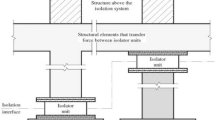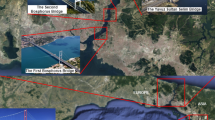Abstract
This study aimed to develop a decision-making support system for managing the seismic performance of aged road facilities in a road network, based on their evaluated seismic performance. This study was divided into two parts. In Part 1, seismic fragility functions are developed for bridges, tunnels, retaining walls, and slopes, while considering aging. In Part 2, the degradation of the seismic performance of the road network, along with social and economic resilience are evaluated based on these seismic fragility functions. The developed decision-making support system was applied to domestic test beds in Korea, and the results are discussed in Part 2. To develop seismic fragility, various ground motions suitable for the ground conditions in South Korea were generated. In particular, reduced- and real-size bridge piers and bearings were tested to study the effect of aging on seismic behavior. Other types of facilities, such as tunnels, retaining walls, and slopes, were also analyzed to study the same. For simplicity, representative facilities that can properly represent the seismic behavior of similar facilities were selected from a large number of facilities. The limit states for these representative facilities were defined, and their seismic fragility curves were calculated using these limit states.
Similar content being viewed by others
References
American Association of State Highway and Transportation Officials (AASHTO) (2017) LRFD road tunnel design and construction guide specifications. AASHTO, Washington DC, USA
American Association of State Highway and Transportation Officials (AASHTO) (2020) LRFD bridge design specifications. AASHTO, Washington DC, USA
Argyroudis S, Kaynia AM, Pitilakis K (2013) Development of fragility functions for geotechnical constructions: Application to cantilever retaining walls. Soil Dynamics and Earthquake Engineering 50:106–116, DOI: https://doi.org/10.1016/j.soildyn.2013.02.014
Baker JW (2008) An introduction to probabilistic seismic hazard analysis (PSHA). White paper, version 1, 72
Bentley (2020) PLAXIS 2D Geotechnical finite element analysis software. Bentley Systems: Advancing Infrastructure. Delft, Netherlands
Caltrans (2013) Caltrans seismic design criteria. Sacramento, CA: California Department of Transportation
CEN (2005) EN 1998-2: Eurocode 8: design of structures for earthquake resistance—Part 2: Bridges. CEN–European Committee for Standardization, Brussels
Chen S, Duffield C, Miramini S, Raja BNK, Zhang L (2021) Life-cycle modelling of concrete cracking and reinforcement corrosion in concrete bridges: A case study. Engineering Structures 237:112143, DOI: https://doi.org/10.1016/j.engstruct.2021.112143
Cornell CA, Jalayer F, Hamburger RO, Foutch DA (2002) Probabilistic basis for 2000 SAC federal emergency management agency steel moment frame guidelines. Journal of Structural Engineering 128:526–533, DOI: https://doi.org/10.1061/(ASCE)0733-9445(2002)128:4(526)
CSI (2011) SAP2000 software, ver15. Berkeley, California, USA
Dalia S, Abdul-Hamid (2008) Reliability-based analysis of strip footings using response surface methodology. International Journal of Geomechanics ASCE 8(2):134–143, DOI: https://doi.org/10.1061/(ASCE)1532-3641(2008)8:2(134)
Ellsworth WL, Llenos AL, McGarr AF, Michael AJ, Rubinstein JL, Mueller CS, Petersen MD, Calais E (2015) Increasing seismicity in the U. S. midcontinent: Implications for earthquake hazard. The Leading Edge 34(6):618–626, DOI: https://doi.org/10.1190/tle34060618.1
Hamano M, Igarashi A, Hayashi K, Adachi Y, Dang J (2014) Experimental evaluation of remaining performance and aging deterioration of elastomeric bridge bearings with natural rubber. The 27th KKHTCNN Symposium on Civil Engineering. Shanghai, China
Haosheng G, Yoshito I, Kazuya S (2005) Effect of rubber bearing ageing on seismic response of base-isolated steel bridges. Fourth International Conference on Advances in Steel Structures 2:1627–1632, DOI: https://doi.org/10.1016/B978-008044637-0/50242-0
Hashash YMA, Musgrove MI, Harmon JA, Ilhan O, Xing G, Groholski D, Phillips CA, Park DH (2020) DEEPSOIL V7.0, user manual. Board of Trustees of University of Illinois at Urbana-Champaign, Urbana, IL, USA
HAZUS (2003) Multi-hazard loss estimation methodology: Earthquake model. Washington (DC): Department of Homeland Security, FEMA
HAZUS (2020) Hazus earthquake technical manual 4-2. Hazus User & Technical Manuals. Washington (DC): Department of Homeland Security, FEMA
Imbsen RA (2013) AASHTO guide specifications for LRFD seismic bridge design. AASHTO, Washington DC, USA
Itasca Consulting Group (2011) FLAC-Fast lagrangian analysis of continua. Ver. 6.0, Minneapolis: Itasca
Japan Road Association (2012) Specifications for highway bridges. Part 4, Japan Road Association
Jeon J-S, DesRoches R, Kim T, Choi E (2016) Geometric parameters affecting seismic fragilities of curved multi-frame concrete box-girder bridges with integral abutments. Engineering Structures 122:121–143, DOI: https://doi.org/10.1016/j.engstruct.2016.04.037
Kaynia MA, Argyroudis S, Mayoral JM, Johansson J, Pitilakis K, Anastasiadis A (2011) D3.7-Fragility functions for roadway system elements. European Project SYNER-G: Systemic seismic vulnerability and risk analysis for buildings, lifeline networks and infrastructures safety gain (FP7-ENV-2009-1-244061)
Kim D, Song J, Lee YJ, Yoon S, Yoon D, Lee Y, Kwon Y, Lee D, Choi Y (2023) Seismic performance management of aging road facilities in Korea: Part 2 - Decision-making Support Technology and Its Application. KSCE Journal of Civil Engineering, DOI: https://doi.org/10.1007/s12205-023-0601-3
Koh C, Ang K, Zhang L (1997) Effects of repeated loading on creep deflection of reinforced concrete beams. Engineering Structures 19(1):2–18, DOI: https://doi.org/10.1016/S0141-0296(96)00028-4
Korea Authority of Land & Infrastructure Safety (KALIS) (2018) Facility management system. Retrieved November 18, 2018, http://www.fms.or.kr.
Korea Authority of Land & Infrastructure Safety (KALIS) (2021) Seismic Performance Evaluation Guideline for Existing Structures. Jinju, South Korea (in Korean)
Korea Electric Power Corporation (KEPCO) (2017) Study on seismic reinforcement plans for existing transmission and distribution on cable tunnel and electric facilities around the Yangsan fault. Naju, South Korea (in Korean)
Kramer SL (1996) Geotechnical earthquake engineering. Pearson Education India
Kunihiro H, Yukio A, Naota S, Akira I, and Ji D (2015) Experimental evaluation of seismic residual performance for deteriorated rubber bearings in highway bridges. Proceedings of Joint 6th International Conference on Advances in Experimental Structural Engineering (6AESE) and 11th International Workshop on Advanced Smart Materials and Smart Structures Technology (11ANCRiSST)
Lee TH, Park D, Nguyen DD, Park JS (2016) Damage analysis of cut-and-cover tunnel structures under seismic loading. Bulletin of Earthquake Engineering 14:413–431, DOI: https://doi.org/10.1007/s10518-015-9835-x
Lu J, Elgamal A, Yang Z (2011) OpenSeesPL: 3D lateral pile-ground interaction. San Diego: University of California
Mander JB, Priestley MJN, Park R (1988) Theoretical stress-strain model fot confined concrete. Journal of Structural Engineering 114(8):1804–1826, DOI: https://doi.org/10.1061/(ASCE)0733-9445(1988)114:8(1804)
Mangalathu S, Jeon J, Padgett JE, DesRoches R (2016) ANCOVA-based grouping of bridge classes for seismic fragility assessment. Engineering Structures 123:379–394, DOI: https://doi.org/10.1016/j.engstruct.2016.05.054
McKenna F, Fenves GL (2006) Open system for earthquake engineering simulation user manual. Open System for Earthquake Engineering Simulation (OpenSees)
Ministry of Construction Transportation (MOCT) (1997) Seismic design criteria research (II) - Seismic design performance standards and economic efficiency, South Korea (in Korean)
Ministry of Land, Infrastructure and Transport (MOLIT) (2004) Seismic Performance Evaluation and Improvement Guideline for Existing Structures (Foundation and Substructures). Sejong, South Korea (in Korean)
Ministry of Land, Infrastructure and Transport (MOLIT) (2018) General seismic design for Korea: KDS 17 10 00. Sejong, South Korea (in Korean)
Ministry of Land, Infrastructure and Transportation (MOLIT) (2020) 2020 Road Bridge and Tunnel Status Report, Sejong, South Korea (in Korean)
Ministry of Public Safety and Security (MPSS) (2017) Minimum requirements for seismic design, Sejong, South Korea (in Korean)
Mott PH, Roland CM (2001) Aging of natural rubber in air and seawater. Rubber Chemistry and Technology 74:79–88, DOI: https://doi.org/10.5254/1.3547641
Nguyen DD, Park D, Shamsher S, Nguyen VQ, Lee TH (2019) Seismic vulnerability assessment of rectangular cut-and-cover subway tunnels. Tunnelling and Underground Space Technology 86:247–261, DOI: https://doi.org/10.1016/j.tust.2019.01.021
Nielson BG (2005) Analytical fragility curves for highway bridges in moderate seismic zones. PhD Thesis. Georgia Institute of Technology. Atlanta, Georgia
Nielson BG, DesRoches R (2007) Seismic fragility methodology for highway bridges using a component level approach. Earthquake Engineering Structural Dynamics 36:823–839, DOI: https://doi.org/10.1002/eqe.655
PWRI (2015) A study on the damage assessment and repair and reinforcement methods for footings Damaged by Alkali Silica Reaction, Civil Engineering Research Institute Data No. 4304
Ramanathan KN (2012) Next generation seismic fragility curves for California bridges incorporating the evolution in seismic design philosophy. PhD Thesis, Georgia Institute of Technology
Rollins K, Hollenbaugh J (2015) Liquefaction induced negative skin friction from blast-induced liquefaction tests with auger-cast piles. In: Proceedings of 6th international conference on earthquake geotechnical engineering, New Zealand Geotechnical Society, Christchurch, New Zealand
Seo H, Kim B, Park D (2021) Seismic fragility evaluation of inverted T-type wall considering site conditions. KSCE Journal of Civil and Environmental Engineering Research 41(5):533–541, DOI: https://doi.org/10.12652/KSCE.2021.41.5.0533 (in Korean)
Seo H, Lee Y-J, Park D, Kim B (2022) Seismic fragility assessment for cantilever retaining walls with various backfill slopes in South Korea. Soil Dynamics and Earthquake Engineering 161, DOI: https://doi.org/10.1016/j.soildyn.2022.107443
Shamsabadi A, Yan L (2008) Closed-form force-displacement backbone curves for bridge abutment-backfill systems. Proceedings of the geotechnical earthquake engineering and soil dynamics IV. American Society of Civil Engineers, 1–10
Soda N, Yamda K, Kimizu T, Hirose T, Suzuki M (2013) Performance test of natural rubber bearing ruptured according to the 2011 off the pacific coast of tohoku earthquake. Journal of Structural Engineering, A 59A:516–526, DOI: https://doi.org/10.11532/structcivil.59A.516
Stringer ME, Madabhushi SPG (2010) Improving model quality through computer controlled saturation. Proceedings of the 7th International Conference on Physical Modelling in Geotechnics, 28 June–1 July, Zurich, Switzerland
Sun D, Huang C, Cao Z, Wu K, Zhang L (2021) Reliability assessment of concrete under external sulfate attack. Case Studies in Construction Materials 15:e00690, DOI: https://doi.org/10.1016/j.cscm.2021.e00690
Tran DTP, Cho Y, Seo H, Kim B (2022) Seismic fragility assessment on earth slopes in South Korea using finite element simulations (under review)
US Department of Transportation Federal Highway Administration (1996) Seismic Design Course Design Example No. 6
Valley L, Perez BFG, Haydon WD, Wiegers MO (2012) California Geological Survey Zones of Required Investigation for Earthquake-Induced Landslides–Earthquake-Induced Landslide Hazard
Wang Z (2011) Seismic hazard assessment: issues and alternatives. Pure and Applied Geophysics 168:11–25, DOI: https://doi.org/10.1007/s00024-010-0148-3
Wu Y, Prakash S (2001) Seismic displacement of rigid retaining walls. International Conferences on Recent Advances in Geotechnical Earthquake Engineering and Soil Dynamics, Proceedings of 4th International Conference on Recent Advances in Geotechnical Earthquake Engineering and Soil Dynamics, California, USA
Zamiran S, Osouli A (2018) Seismic motion response and fragility analyses of cantilever retaining walls with cohesive backfill. Soils and Found 58(2):412–426, DOI: https://doi.org/10.1016/j.sandf.2018.02.010
Acknowledgments
This research was supported by a grant (21SCIP-B146946-04) from Smart Civil Infrastructure Research Program funded by Ministry of Land, Infrastructure and Transportation of Korean Government. The authors appreciate the contributions of Oh-Sung Kwon, Jong-Han Lee, Seong-Hoon Jeong, Jong-Keol Song, Jinsup Kim, Byung Ho Choi, and Seungjun Kim in finalizing this paper.
Author information
Authors and Affiliations
Corresponding author
Rights and permissions
About this article
Cite this article
Shin, S., Kim, I., Song, KI. et al. Seismic Performance Management of Aged Road Facilities in Korea: Part 1 — Fragility Curves. KSCE J Civ Eng 28, 1853–1872 (2024). https://doi.org/10.1007/s12205-024-0598-2
Received:
Revised:
Accepted:
Published:
Issue Date:
DOI: https://doi.org/10.1007/s12205-024-0598-2




